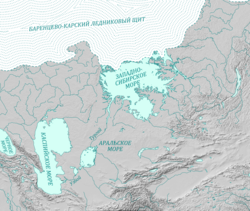Earth:West Siberian Glacial Lake

The West Siberian Glacial Lake, also known as West Siberian Lake (Russian: Западно-Сибирское море) or Mansiyskoe Lake (Russian: Мансийское озеро), was a periglacial lake formed when the Arctic Ocean outlets for each of the Ob and Yenisei rivers were blocked by the Barents-Kara Ice Sheet during the Weichselian Glaciation, approximately 80,000 years ago. It was situated on the West Siberian Plain, and at its maximum extent the lake's surface area was more than 750,000 km2 which is more than twice that of the present-day Caspian Sea.
It is theorized that although drainage to the Arctic Ocean basin (e.g. by the Ob and Yenisei Rivers) was prevented, the lake would eventually overflow to the Mediterranean Sea through a circuitous route that would include the Aral Sea, the Caspian Sea, and the Black Sea. This would have resulted in water from the Selenga River and Lake Baikal draining over a course of some 9,700 kilometres (6,000 mi), considerably longer than any river's course today.[1]
| Date | Elevation | Area | Volume | Average depth |
|---|---|---|---|---|
| 90–80 ka | 60 m | 610000 km2 | 15000 km3 | 24 m |
| 60–50 ka | 45 m | 881000 km2 | 32000 km3 | 36 m |
See Mangerud et al. (2004)[2] for diagrams and descriptions of the lake as well as postulated drainage patterns.
See also
- the Baikal seal, a freshwater seal of Lake Baikal probably related to Caspian seals.
- the Turgai Sea or West Siberian Sea, a Cretaceous to Eocene extension of the Tethys Sea separating Europe and Asia
- Paratethys
Notes
- ↑ Dutch, Steve, Professor of Natural and Applied Sciences, University of Wisconsin-Green Bay. "Pleistocene Glaciers and Geography" webpage (accessed 30 November 2006)
- ↑ Mangerud, J.; Jakobsson, M.; Alexanderson, H.; Astakhov, V.; Clarke, G. K. C.; Henriksen, M.; Hjort, C.; Krinner, G. et al. (2004). "Ice-dammed lakes and rerouting of the drainage of northern Eurasia during the Last Glaciation". Quaternary Science Reviews 23 (11–13): 1313–1332. doi:10.1016/j.quascirev.2003.12.009. Bibcode: 2004QSRv...23.1313M.
External links
 |

